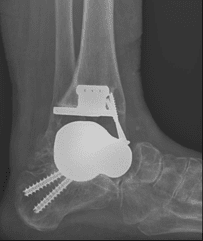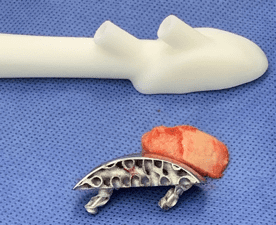Ankle arthrodesis
WHAT IS ANKLE ARTHRODESIS?
The goal of ankle arthrodesis (also known as ankle fusion) is to relieve pain and maintain or improve function for patients with ankle arthritis. Ankle arthritis is degeneration of the cartilage that covers the ends of the bones that form the ankle joint. These bones are the tibia, the fibula, and the talus. Pain typically is made worse with movement of the arthritic ankle. In ankle arthrodesis the ankle bones are fused into one bone. This eliminates the joint motion and reduces pain coming from the arthritic joint.
Diagnosis
Patients may be candidates for ankle arthrodesis if they have severe ankle arthritis and non-surgical treatments have failed. Many patients may find relief from the pain associated with ankle arthritis using:
Anti-inflammatory medication (such as ibuprofen)
Injections of steroids into the ankle joint or regenerative injections (PRP/Amnio Flowable)
Modification or limitations of activity walking aids (such as canes)
Specialty braces that stabilize the ankle and restrict its movement
Cushioned and specially contoured shoes
These treatments do not reverse ankle arthritis. In many patients they may temporarily or permanently provide relief from pain. If these measures fail to provide adequate pain relief or maintain function, a patient may be a candidate for ankle fusion. You should discuss your options with your foot and ankle surgeon.
Patients should avoid ankle arthrodesis if they have:
Insufficient quantity or quality of bone for fusion
Poor blood supply to the ankle
Severely impaired nerve function
Medical conditions that increase the risk of anesthetic
Severe deformity of the limb
Treatment
Patients are asleep or sedated in the operating room during the procedure. Incisions
are made in and around the ankle to access the joint. Any remaining cartilage within the ankle joint is removed so there is contact between the bony surfaces. The ankle is held in the most functional position with metal hardware. This allows the bones to heal together.
Specific Technique
Ankle arthrodesis may be performed through an incision on the outside of the ankle or the front of the ankle. Sometimes ankle arthrodesis can be performed through a minimally invasive technique in which a camera and tools are placed into the joint. This is known as arthroscopic surgery.
Sometimes a bone graft may be used to aid in fusion. This graft may be taken from the pelvis, heel bone, or just below the knee. After the joint has been
accessed, tools are used to scrape away remaining cartilage and the joint surface is prepared for fusion. Screws or screws and plates may be used to hold the ankle in the correct position. If a patient is having their subtalar joint fused at the same time, a nail or rod may be used to hold the
joints in position. Hardware may be placed through the incision used to access the ankle joint and/or through small poke holes. In rare cases, pins and bars outside the skin are used to hold the ankle in position.
X-rays are used during surgery to check the alignment of the joint and the placement of hardware. The choice of approach and hardware depends on a patient’s specific anatomy and condition, and the surgeon’s preference.
Incisions are closed with sutures or staples. Patients are often placed in splints or plastic boots to protect the ankle fusion.
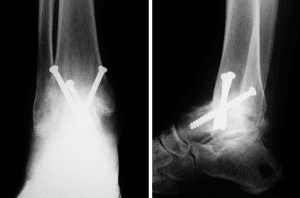
These are X-rays of a patient who had an ankle joint fusion. The ankle joint between the tibia and talus is not visible because the two bones are fused together as one bone. In this patient, this was done with three screws across the ankle joint.
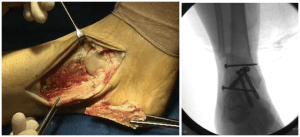
A lateral approach with the fibula removed and excellent access to the ankle joint. The fibula was then replaced on the lateral aspect of the fusion site to assist in healing and provide increased stabilization to the fusion.
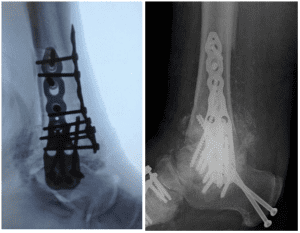
A lateral approach was used in this patient

An Anterior approach was used to fuse this ankle with an anterior ankle fusion plate and external screw.
Recovery
During the immediate post-operative period it is important to keep the fused ankle elevated to minimize swelling. Ideally this means keeping the ankle above the heart by lying down or sitting in a reclined position. Pain medication is provided for this short period of time.
It will take at least 6-8 weeks for the tibia and talus to be fused sufficiently for patients to begin putting weight on their operative leg. It may take as long as 10-12 weeks. Most patients find navigating their daily lives without putting weight on one leg difficult. Patients typically use crutches, walkers, wheelchairs, or knee scooters. Preparation with a physical therapist prior to surgery may be advisable. It is helpful to have someone on hand to help with basic tasks and activities at home, especially during the first two weeks. A patient’s home should be prepared appropriately. Ramps may be needed to navigate stairs. Beds may need to be transferred to ground level. Aids such as shower chairs, commodes, and railings may be needed.
Non-absorbable stitches or staples typically are removed 10-14 days after surgery. Gentle physical therapy to keep the other joints in the foot supple may begin at this time. X-rays may be taken to check that alignment has not changed. During the first few weeks after surgery, swelling and pain will increase when the foot is below the heart for extended periods of time. Mild amounts of swelling and pain when the foot is below the heart for long periods of time may persist for months, but will improve over time.
After sufficient time has passed, patients slowly begin placing weight on their ankle using a walking boot. X-rays may be obtained to confirm that the ankle is fusing well. Physical therapy will aid in this transition. After 10-12 weeks, the ankle fusion typically is sturdy enough to allow walking out of the plastic boot and a gradual return to more vigorous activity.
Risks and Complications
All surgeries come with possible complications, including the risks associated with anesthesia, infection, damage to nerves and blood vessels, and bleeding or blood clots.
A specific risk associated with ankle arthrodesis is nonunion, or failure of the ankle bones to fuse together. The ankle bones successfully fuse in more than 90% of operations, so the risk is relatively low. If nonunion does occur, a second operation to place bone graft in the ankle and place new hardware may be needed.
Loss of motion in the ankle after a fusion causes the other joints in the foot to bear more stress than they did prior to the surgery. This can lead to an increased rate of arthritis in those other joints. This typically takes several years to develop and may or may not be symptomatic.
Questions:
Will I lose all motion in my foot?
The ankle joint is responsible for the majority of up-and-down motion. Ankle fusion decreases this movement, but the movement of the subtalar joint and the other joints of the foot remains. This allows the heel to move from side to side and the middle of the foot to move up and down. A fused ankle typically does not result in a fully rigid foot. Ankle arthrodesis does change how a person walks, however, with proper shoes most patients do not limp.
Are there activities I should avoid with an ankle arthrodesis?
Once the ankle has fused, it is quite durable. Many patients work physically demanding jobs, walk long distances, hike, cycle, and ski on fused ankles. The fused ankle will never function exactly like a normal ankle, however. Patients are encouraged to discuss specific hopes for return to activity with their foot and ankle surgeon. Running and similar activities are not recommended.
Do I need to have the plates or screws removed?
No. Occasionally the plates and screws may be removed if they are close to the skin and cause irritation. They may also need to be removed if an infection develops. Otherwise, hardware is not typically removed. There is usually not enough hardware in place to set off metal detectors.
Ad Space
Book An Apointment
Contact Us
If you have any questions about our services or how we can help, please contact us so we can start working with you on the road to restoring your ankle to it's full potential.


